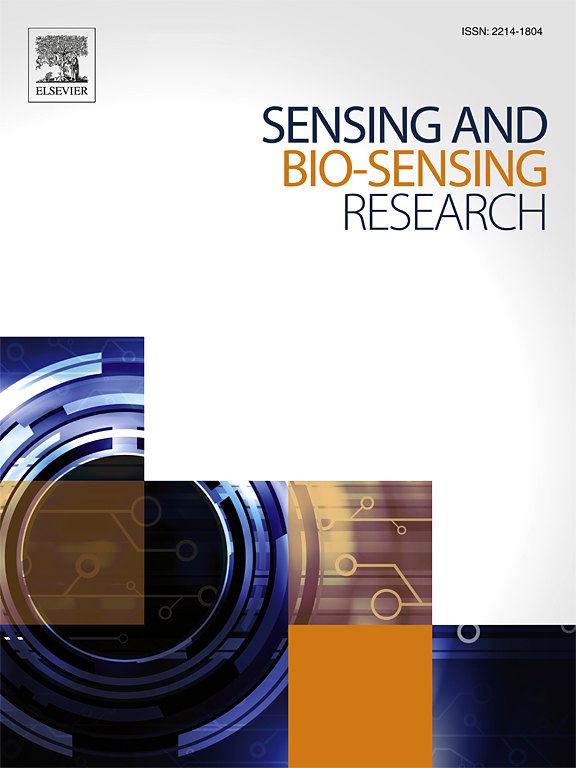CoW11CpFe@Cu-BTC/MWCNTs-COOH修饰玻碳电极同时检测多巴胺和尿酸的制备及其电催化性能
IF 4.9
Q1 CHEMISTRY, ANALYTICAL
引用次数: 0
摘要
多巴胺(DA)和尿酸(UA)的同时检测在临床上具有重要意义,但由于它们具有相似的性质,这往往导致传统诊断方法的敏感性和特异性较差。为了解决这个问题,该研究提出了一种新型杂交nanocomposite-POM@MOF/ mwcnts - cooh,用于选择性和敏感地检测这两种生物标志物。利用傅里叶变换红外光谱(FT-IR)、x射线衍射分析(XRD)、透射电子显微镜(TEM)、电感耦合等离子体发射光谱(ICP-OES)、布鲁诺尔-埃米特-泰勒(BET)分析、x射线光电子能谱(XPS)和场发射扫描电子显微镜(FE-SEM)对材料进行了全面表征。电化学分析采用循环伏安法(CV)、差分脉冲伏安法(DPV)和安培法。在最佳条件下,该传感器对DA的线性检测范围为5 ~ 100 μM和100 ~ 550 μM, LOD为0.16 μM;对UA的线性检测范围为200 ~ 950 μM和950 ~ 4450 μM, LOD为0.82 μM。这些发现突出了我们的新型混合纳米复合材料作为临床诊断工具的潜力。这种创新的混合纳米复合材料在DA和UA检测方面比现有的传感平台具有显著的优势。其独特的高酸度、富氧表面和强大的氧化还原能力的结合,使两种分析物的同时检测具有更高的灵敏度和特异性。该传感器卓越的电催化性能使其成为临床诊断的一种有前途的工具,通过在临床相关浓度下准确检测生物标志物,有可能改善医疗保健结果。本文章由计算机程序翻译,如有差异,请以英文原文为准。
Fabrication and electrocatalytic performance of CoW11CpFe@Cu-BTC/MWCNTs-COOH modified glassy carbon electrode for simultaneous detection of dopamine and uric acid
Simultaneous detection of dopamine (DA) and uric acid (UA) is clinically important but challenging due to their similar properties, which often lead to poor sensitivity and specificity in traditional diagnostic methods.
To address this, the study presents a novel hybrid nanocomposite-POM@MOF/MWCNTs-COOH-engineered for the selective and sensitive detection of both biomarkers. The material was thoroughly characterized using Fourier transform infrared spectroscopy (FT-IR), X-ray diffraction analysis (XRD), transmission electron microscopy (TEM), inductively coupled plasma-optical emission spectrometry (ICP-OES), Brunauer-Emmett-Teller (BET) analysis, x-ray photoelectron spectroscopy (XPS), and field-emission scanning electron microscopy (FE-SEM). Electrochemical profiling was conducted using cyclic voltammetry (CV), differential pulse voltammetry (DPV), and amperometry. Under optimal conditions, the sensor demonstrated linear detection ranges of 5–100 μM and 100–550 μM for DA, with a limit of detection (LOD) of 0.16 μM, and 200–950 μM and 950–4450 μM for UA, with an LOD of 0.82 μM, as determined by DPV. These findings highlight the potential of our novel hybrid nanocomposite as a promising tool for clinical diagnostics. This innovative hybrid nanocomposite offers significant advantages over existing sensing platforms for DA and UA detection. Its unique combination of high acidity, oxygen-rich surface, and robust redox capabilities enables simultaneous detection of both analytes with enhanced sensitivity and specificity. The sensor's exceptional electrocatalytic performance positions it as a promising tool for clinical diagnostics, potentially improving healthcare outcomes through accurate biomarker detection at clinically relevant concentrations.
求助全文
通过发布文献求助,成功后即可免费获取论文全文。
去求助
来源期刊

Sensing and Bio-Sensing Research
Engineering-Electrical and Electronic Engineering
CiteScore
10.70
自引率
3.80%
发文量
68
审稿时长
87 days
期刊介绍:
Sensing and Bio-Sensing Research is an open access journal dedicated to the research, design, development, and application of bio-sensing and sensing technologies. The editors will accept research papers, reviews, field trials, and validation studies that are of significant relevance. These submissions should describe new concepts, enhance understanding of the field, or offer insights into the practical application, manufacturing, and commercialization of bio-sensing and sensing technologies.
The journal covers a wide range of topics, including sensing principles and mechanisms, new materials development for transducers and recognition components, fabrication technology, and various types of sensors such as optical, electrochemical, mass-sensitive, gas, biosensors, and more. It also includes environmental, process control, and biomedical applications, signal processing, chemometrics, optoelectronic, mechanical, thermal, and magnetic sensors, as well as interface electronics. Additionally, it covers sensor systems and applications, µTAS (Micro Total Analysis Systems), development of solid-state devices for transducing physical signals, and analytical devices incorporating biological materials.
 求助内容:
求助内容: 应助结果提醒方式:
应助结果提醒方式:


